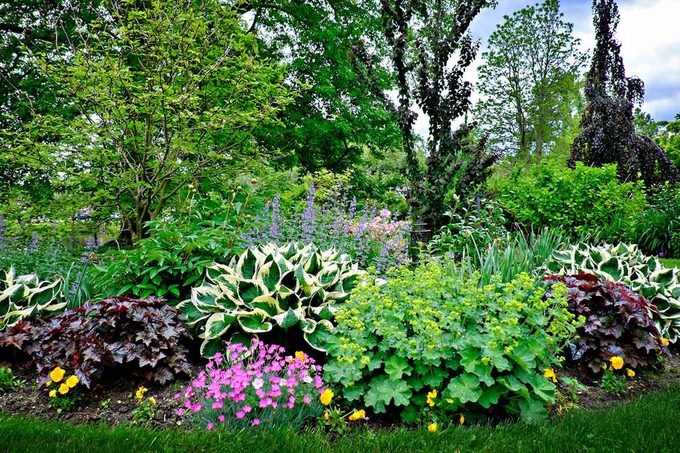Those new to gardening may occasionally confuse annuals and perennials. After all, wouldn’t it seem logical that an annual comes back, er, annually? But that’s only if seed is dispersed — annually, as it were — to get a replacement plant in the works. It is actually the perennial that comes back year after year and an easy way to remember that is to think of it as a perennial guest in the garden.
What Is a Perennial?
A perennial is a plant that lives two or more years. The term is also used to differentiate herbaceous plants (those with non-woody stems) from trees and shrubs, which obviously have woody stems that persist year after year. With flowers, perennials are the champs in terms of lifespan. Yes, you pay a little more for them at the garden center, but you get to enjoy your purchase year after year. One drawback: unlike annuals, which bloom nonstop until frost, perennials generally flower for two or three weeks. Fortunately, there are exceptions that flower far longer — ‘Goldsturm’ black-eyed Susan and ‘May Night’ salvia are two examples.
Types of Perennials
There are three basic types of perennials: Tender, Short-Lived and Long-Lived. Tender perennials are those that won’t survive cold winter weather. A lot of plants grown as annuals (think petunias) can live year after year in tropical climates. On the other hand, short-lived perennials decline or fade away over time, as columbine (Aquilegia), blanketflower (Gaillardia) and rose campion (Lychnis) tend to do. Fortunately, the mother plants often furnish replacement generations, either through seeds or roots. Finally, long-lived perennials, such as peonies, can last for generations (one reason you find them growing in cemeteries).
How to Choose Perennials
- When buying a perennial, always consider hardiness. Make sure its USDA Plant Hardiness Range includes your Zone. Don’t rely on the nursery — some sell non-hardy perennials that won’t survive the winter.
- Also, compare the spot you want to fill with the perennial’s preferred growing conditions (sun vs. shade, moist vs. well-drained).
- Aesthetically, consider the plant’s features. Some perennials, such as hostas and coralbells (Heuchera), are grown primarily for their foliage, so you get season-long interest.
- Here are some perennials that make good ground cover plants.
- Others are grown for their flowers. The question is, when do those flowers appear? If it’s just for a few short weeks in spring, be sure to augment with perennials that bloom later. And while many cultivars are bred for a longer season of bloom, it’s still a good idea to pop in some annuals for a season-long blast of color in your garden.
10 Easy Perennials

Here are some tried-and-true perennials for beginners.
- Autumn Joy Sedum
- Black-eyed Susan (Rudbeckia)
- Daylily (Hemerocallis)
- Helen’s Flower (Helenium autumnale)
- Hosta
- Purple Coneflower (Echinacea purpurea)
- Russian Sage (Perovskia atriplicifolia)
- Shasta Daisy (Leucanthemum x superbum)
- Tickseed (Coreopsis)
- Yarrow (Achillea)
When to Plant Perennials
You can plant nursery-grown perennials throughout the season, but cooler spring temperatures will be less stressful on the plants. If transplanting a perennial from your yard or someone else’s, you can reduce the shock of transplanting by working in the cooler temperatures of spring and fall. In most cases, it’s best to transplant perennials when they are dormant if possible.
How to Plant Perennials
- When planting a perennial bed, spread a two- to three-inch layer of compost and mix it into the soil. When planting just one or two perennials, mix the compost into the soil you excavate.
- Dig a hole that is the same depth as the root ball and twice as wide.
- Tease the roots so that they are not winding in a circle, then plant the perennial at the same depth it grew in the nursery pot.
- After backfilling the hole, mulch with shredded leaves, bark mulch, cocoa shells or wood chips (use stones around cactus and succulents, which require rapid drainage). In either case, do not allow mulch to touch the plant crown, which is where the stem meets the roots.
- Water generously right after planting and throughout the season until plants have grown some roots and established themselves.
How to Maintain Perennials
Perennials are not hard to grow, but they’re not maintenance free, either. Most die back to the ground in cold-winter regions, so plan on removing their dead top growth either in late fall or early spring. Many gardeners allow perennials with rigid stems to remain intact over the winter because it adds visual interest to the winter garden and will feed birds if there are seeds involved.
It helps to spread a shovelful of compost and some slow-release granular fertilizer around plants in the spring. Also, some perennials need dividing after four or five years. If you see the center of the plant start to die out and become woody or bare, it is time to divide the perennial. Dig it up, preferably when dormant, split the root clump with a sharp spade or root saw, then replant the separated portions (minus the bare center) where desired. Dividing perennials not only reinvigorates them, it provides you with more plants!
Article source here: Homeowner’s Guide to Planting and Growing Perennials


No comments:
Post a Comment